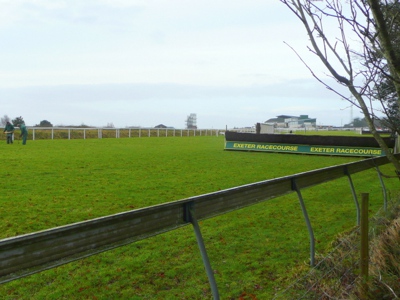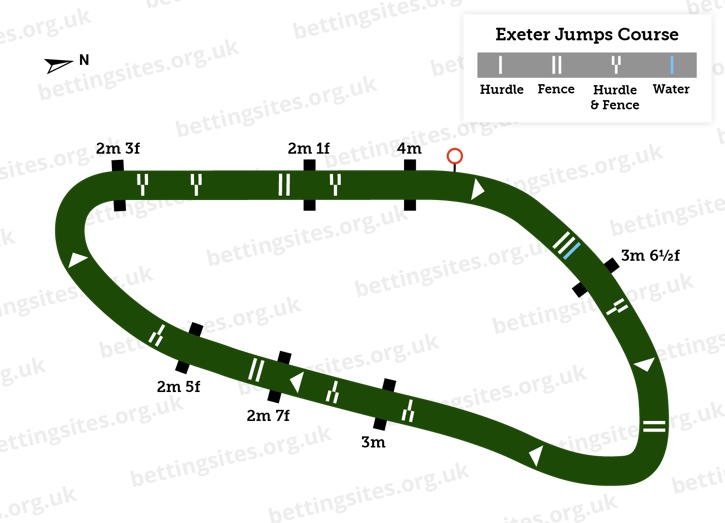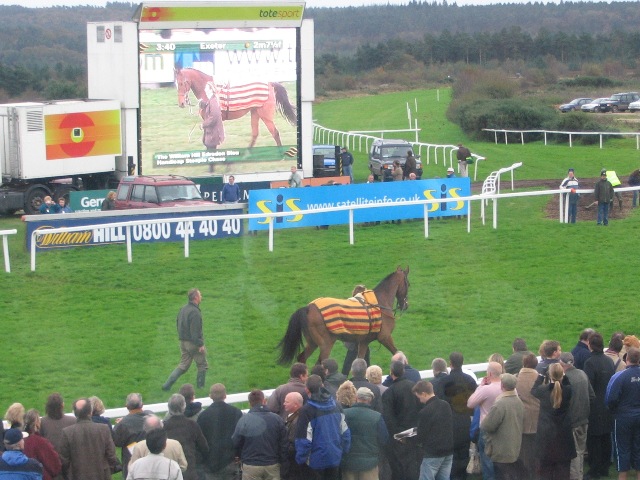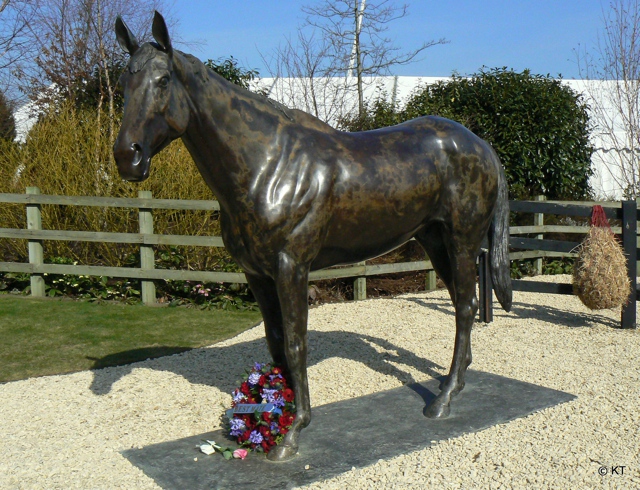Exeter Racecourse Guide

Standing at 260m above sea level, on top of the Haldon Hills, Exeter finds itself as the highest racecourse in the country. From this vantage point, spectators are treated to some wonderful views especially those down towards Dartmoor.
Arguably the South West’s most prestigious racing venue, Exeter brings some good quality jump racing to the region throughout the National Hunt season. Locals sometime refer to it as the Haldon Racecourse but for everybody else it has been known as Exeter Racecourse since the early 1990s (formerly the Devon and Exeter Racecourse).
Jump to: Course | Races | Useful Info | History
Map
The Course

With the oval course at Exeter being two miles long, it’s one of the longest circuits around and this means there are long straights which suit galloping horses. It’s right-handed, unlike most, but there are only two real corners per lap so horses who aren’t keen on turning the other way aren’t as badly disadvantaged as they might be elsewhere. While there is an absence of turns though, there is certainly not an absence of hills, making Exeter a very undulating course. This makes stamina a big factor.
While conditions can be tough during the wetter months, the ground at Exeter is regularly in great shape. The course remains a firm favourite among jockeys and trainers alike who view it as a great place to test out novice chasers. The 11 fences are very fair, much like the rest of the course and it’s a place that is very easy on the eye. Races at Exeter often provide entertaining finishes too, as there are four fences to tackle on an uphill home straight of half a mile.
Major Races
The Haldon Gold Cup is undoubtedly Exeter’s biggest race. The Grade 2, two mile and one and a half furlong race is scheduled to take place in either late October or early November. It’s seen many fine chasers in attendance, such as a six-year-old Cue Card who absolutely romped home in 2012, 26 lengths clear of the nearest challenger. It’s the showpiece of Gold Cup Day at Exeter, an occasion that sees over £100,000 in prize money paid out. That may not seem like a lot compared to the biggest meetings but for a relatively small track it is a considerable fund.
The Haldon Gold Cup is Exeter’s only race of graded quality but a mention must go to the races that feature on the New Year’s Day meeting. It’s one of Exeter’s most popular meetings, regularly attracting big crowds and big names from within the racing community. Certainly one way to shake off the hangover!
Visiting

Exeter made the news in 2011 when one lucky punter there claimed £1.45m from a £2 Tote bet. Why not go and see if you could be part Exeter’s next good luck story?
Useful Info
Dress Code
There is no dress code to worry about at Exeter, although smart casual clothing and dressing for the weather is advised. Fancy dress is allowed at all meetings but must not be considered inappropriate or offensive.
Ticket Prices
For most racedays, entry in the Grandstand & Paddock Enclosure will cost £10-13 in advance or £15 on the day. There are sometimes special promotions when purchasing advanced tickets so booking early is encouraged.
A spot in the Haldon Premier Stand costs a little more, £18 in advance or £20 on the day and this applies to the vast majority of racedays. There is also the Haldon Premier Package at £25 which provides you with a £5 meal voucher, racecard and drink on top of admission.
For those wanting a bit more to eat, prices in the Desert Orchid Restaurant are usually £80 per person. Students with a valid NUS card can get 50% off tickets at the gate on selected days and accompanied children under 18 get in free.
Membership
Annual badge membership at Exeter costs £195, covering all 15 fixtures as well as many other reciprocal dates. With this you can claim discounts in the Desert Orchid Restaurant, as well as at a range of local companies.
People aged 18-24 can select this membership but also have the choice of South West Junior Membership at £115. This gives access to Cheltenham*, Exeter, Warwick and Wincanton (*excludes the Festival) for a full 12 month period starting on 1st October but does not include any reciprocal fixtures.
Getting There
If driving to Exeter, be wary that access is via a sharp bend shortly after the brow of Haldon Hill. For public transport users, Exeter St. Davids is the nearest train station and direct trains run from London Paddington. From the train station and from Exeter bus station, a free bus service runs every raceday.
There is only one bus, however, and spaces are issued on a first come first service basis. If this service is full you can get a taxi, (if using Gemini Taxis, use code EX1 for an exclusive raceday discount) or take the number 39 public bus service.
Parking
There is plenty of free parking every raceday just a short walk from the racecourse.
History

Charles II and his love for horse racing was credited with bringing racing to Exeter in the 17th century. While its origins do stretch back this far, it wasn’t until 1769 when the first meeting was held, 19 years after the Jockey Club introduced standardised rules for horse racing. The first prize money handed out totalled £50, which was a lot of money at the time.
Little is known about the racecourse in the decades that followed but evidence does reveal that in 1833, the racecourse was the place of the last ever reported duel in Devon. Although National Hunt popularity waned around this time, something noted in the local press, it picked up again towards the end of the century.
Renovations
With interest on the rise, work on a new grandstand was completed in 1911 at a cost of £1,000. It could accommodate more than 600 people, most of whom would be under cover. The steel-based structure with an iron roof remained for some time before it was replaced in 1992 with a more modern facility.
Best Mate
In more recent history, Exeter has been home to some horses who have go on to achieve great things. It’s the place where Desert Orchid won his first chase in 1985, much like Best Mate in 2000 and Denman in 2006, who would go on to win the Cheltenham Gold Cup two seasons later.

